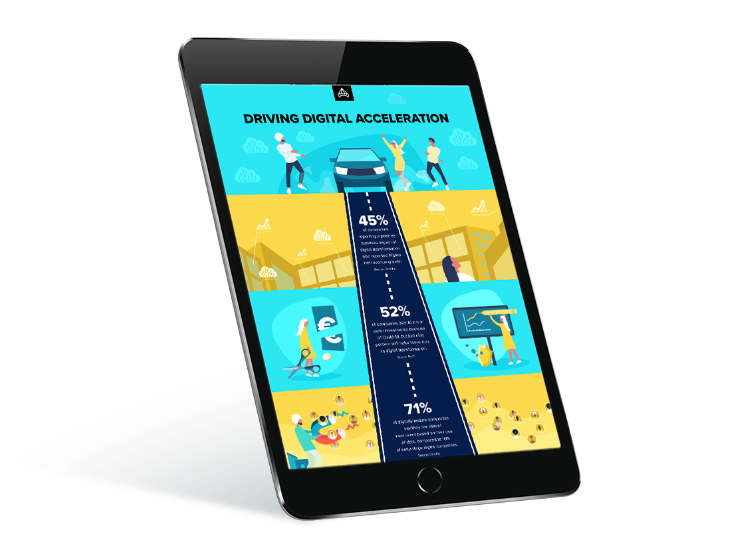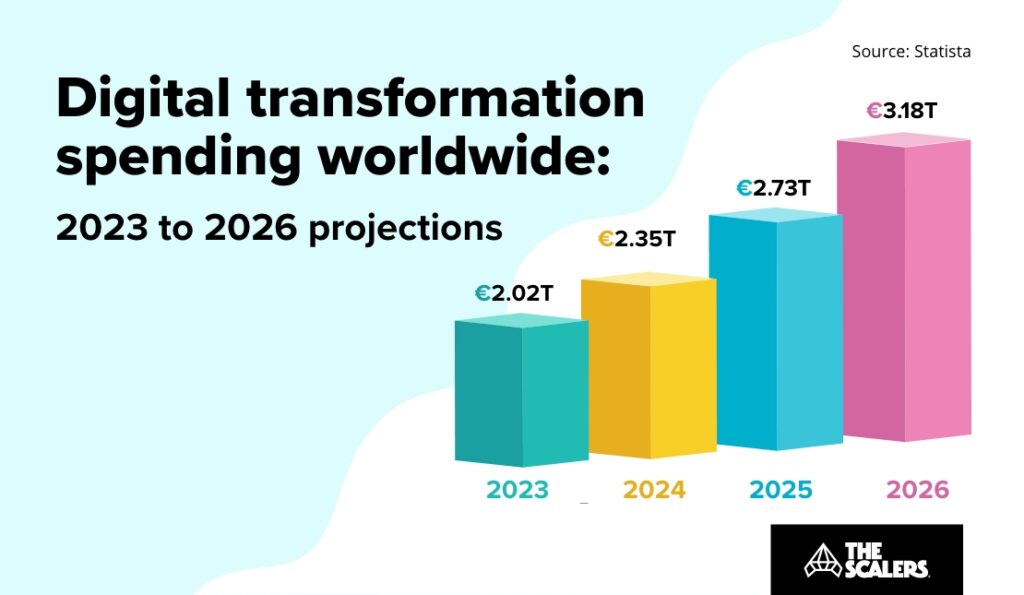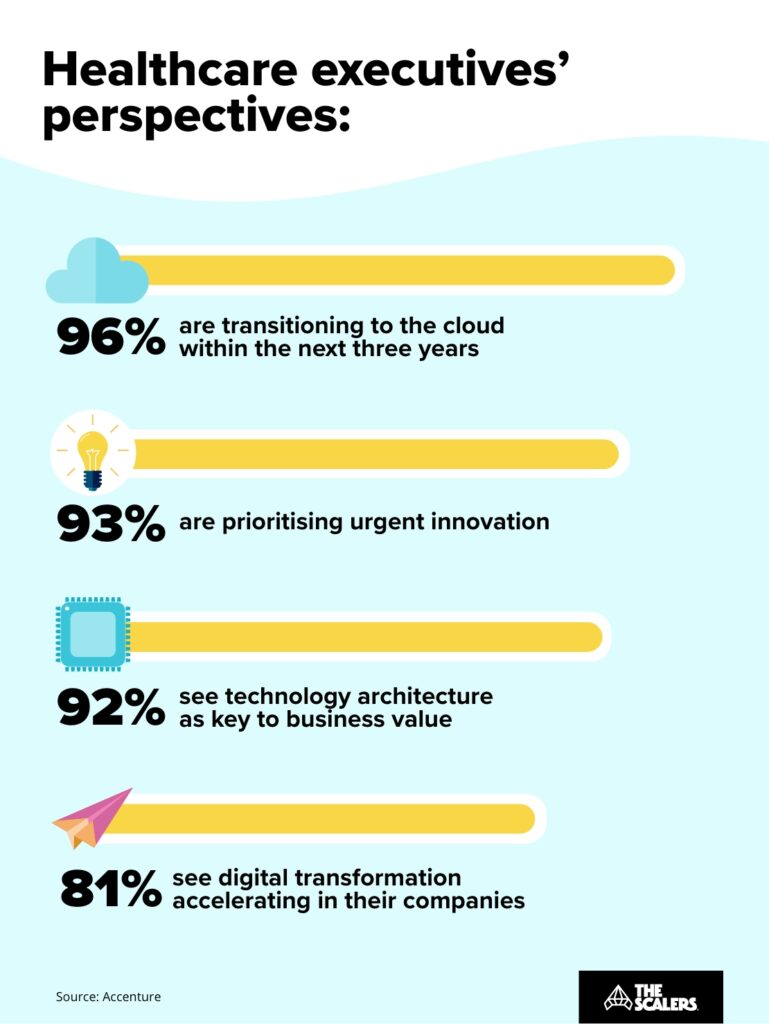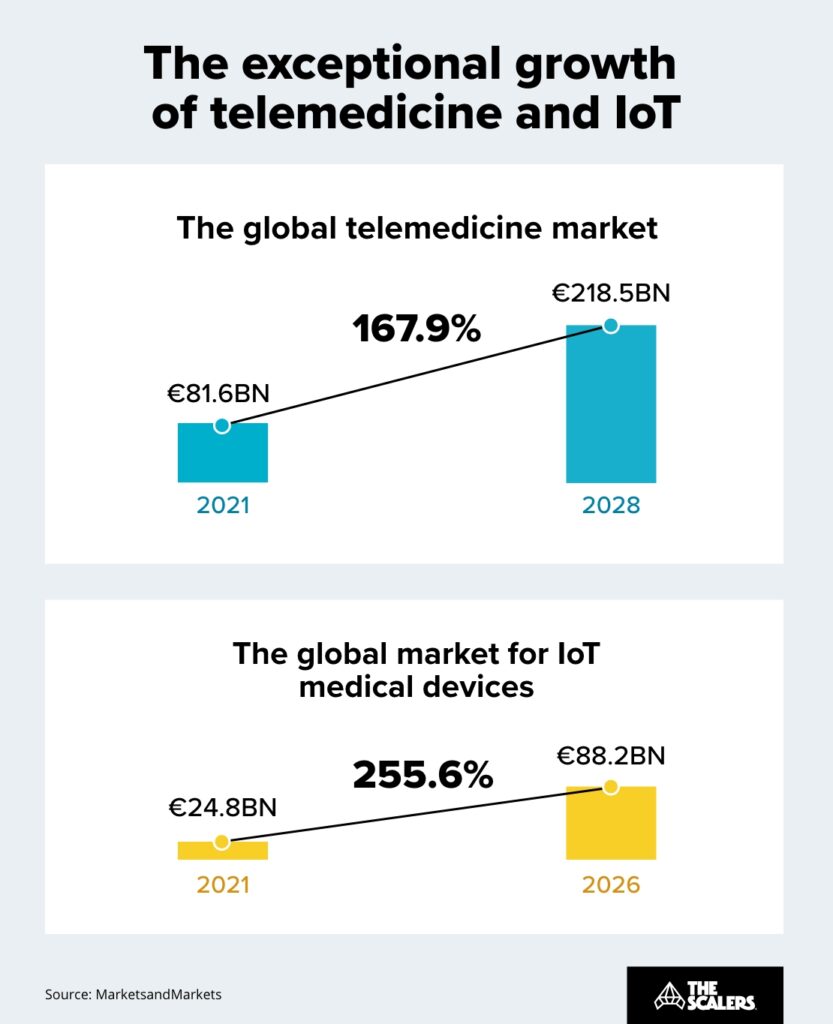A quick guide to digital transformation in the healthcare industry

Technology has transformed every industry from bottom to top, and healthcare is no exception.
Over the past few years, the medical sector, known for its reluctance to shift and adopt new processes, has undergone unprecedented changes. The impact of the COVID-19 global pandemic and the democratisation of advanced tech has accelerated this transition.
Remote consultations, easy access to medical records, and better diagnosis are benefits digital transformation in the healthcare industry has already brought to patients.
Although challenges remain to be addressed, like concerns over privacy and security requirements, the pros outweigh the cons. Digital transformation is here to stay and redefine the way we work and live.
Before diving into the upsides, downsides and trends in health technology, let’s cover the basics.
What’s digital transformation in the healthcare industry?
Digitalisation in the health industry involves introducing technology to improve medical services and workflows for healthcare institutions and patients.
This can involve many of the same tools and trends transforming other industries, like the manufacturing sector or the automotive field, with a critical difference. The ultimate goal of digital transformation in the healthcare industry is to reduce the communication distance between patients, doctors, and operators.
Why does it matter?
The healthcare industry seeks digital transformation to enhance customer satisfaction and patient care for the following seven key reasons:
- Improve access to healthcare services and information
- Enable seamless communication and collaboration among healthcare providers
- Boost patient engagement and empowerment
- Streamline administrative tasks and reduce paperwork
- Enable targeted care through data-driven insights
- Facilitate remote consultations and telemedicine for convenient access to care
- Foster innovation and research for the development of new treatments and technologies
Revolutionary advancements in medical health today include automation, smart ambulances transmitting vital patient data in real-time, and health wearables empowering individuals to track their metrics for better self-care.

Don’t get left behind in the shift to digital business
The rise of blood and glucose trackers monitored via smartphones and the mass adoption of 5G-connected ambulances are just a glimpse of what’s to come.
Benefits of health tech for medical facilities:
- Efficient workflow processes
- Fewer costs and better ROI (return on investment)
- Smooth communication with patients
Benefits of health tech for patients:
- Better and more personalised service
- More accurate diagnosis
- User-friendly access to health records
- Easy appointment scheduling
- Remote medical consultations

It’s no wonder huge investments are being made. Still, there remain some significant barriers preventing further adoption and transformation.
Challenges in implementing digital transformation in healthcare
Statista says global spending on digital transformation will reach $3.4 trillion worldwide by 2026. The same study suggests that Denmark is the most digitally competitive country.
However, the growth rate in North America & most European countries is mid-range. Companies in these regions, including healthcare centres, have either just started digital transformation or are yet to start.
What are the reasons for this slow development in health tech?
Cybersecurity concerns
Data leaks and privacy breaches are a headache for health organisation executives.
The digital transformation in the healthcare industry allows companies to collect more data and patient information than ever before. As data grows, so does the vulnerability to cyberattacks.
Cybercriminals target sensitive and precious personal health data, which can disrupt patient care. To overcome this challenge, cybersecurity experts recommend adopting blockchain technology, among other solutions.
The US Health Insurance Portability and Accountability Act (HIPAA) and the General Data Protection Regulation (GDPR) in Europe are responsible for regulating and protecting patients’ data. The infringement of these regulations results in severe fines and reputational damage to health institutions that don’t meet legal standards.

Increase innovation and deliver at speed in the Silicon Valley of Asia
LEARN MORELack of investment
Digital transformation in healthcare requires considerable investments in technology and partnering with a software development company.
Still, not all health tech leaders are willing to spend money and time exploring the value proposition digital transformation can deliver to their businesses. They primarily focus on ROI and other key metrics to guarantee financial figures add up.
Ironically, investing in new tech offers higher scalability, more profits, and increased revenue for health organisations. The old-fashioned approach often yields limited growth and slower adaptation to market demands.

Slow tech adoption
Healthcare professionals aren’t proficient in tech. Or, at least, they aren’t prepared yet for the ongoing digital transformation in the medical industry.
The ageing workforce in certain countries plays a significant role in tech adoption and the ease of learning new software. For instance, in the UK, 27% of nurses are between 45 and 54 years old, and more than one in six (17.6%) are 55 and over.
Plus, healthcare professionals work on tight schedules. They often need help finding adequate learning time and familiarising themselves with new software.

Emerging trends in digital transformation within the healthcare industry
Keeping up with the ever-changing landscape in health tech seems impossible. That’s why we’ve compiled a short list of the three most important trends in the healthcare industry for years to come.
AI and machine learning
AI is taking over the world by storm. But does it live up to its hype in the healthcare industry?
Short answer, yes. Major companies like IBM, Microsoft and numerous startups are developing tools to assist medical processes.
AI’s ability to learn and improve from data exposure is particularly advantageous in healthcare. Despite data storage and ownership challenges, analysing untapped data holds tremendous potential to deliver significant results for patients and doctors.
According to Phillips’s Future Health Index 2022, 60% of healthcare leaders prioritise investing in AI. While the outcomes are yet to be seen in the coming years, it’s essential to note that AI won’t replace health professionals in their jobs. Instead, it will make them more efficient workers.
Telemedicine
Telemedicine means treating patients remotely via regular phone, video, or chat.
Since the COVID-19 pandemic, virtual doctor visits have become popular and a cost-effective solution for patients and health organisations. Who could have guessed that people can be diagnosed from the comfort of their homes?
Today, 80% of consumers have used telemedicine at least once. And the number of people keeps increasing.
As of now, there are two forms of telemedicine: synchronous telemedicine and asynchronous telemedicine.
The first option involves real-time interaction where the patient and the healthcare professional are present to establish a communication link. The second option entails gathering medical data and transmitting it to a medical specialist at a convenient time for offline assessment.

How we helped a Legal SaaS company scale its Ruby on Rails team to deliver a groundbreaking product
DOWNLOAD CASE STUDYIoT (Internet of Things)
If telemedicine focuses on software and virtual patient portals, IoT is all about innovative healthcare hardware.
IoT has and will continue changing people’s lives thanks to the development of portable gadgets such as heart rate devices and wearable sensors to monitor patients with Parkinson’s disease.
This tech is beneficial for keeping track of older people with chronic pathologies who cannot frequently visit medical centres or live in rural areas. IoT devices allow doctors to make faster decisions and act promptly in life-threatening conditions.

In summary
With digital transformation rapidly changing industries, like the fintech world, the question is not if companies should adopt digitalisation. It’s when and how.
Executives who rely on traditional approaches to tech health will soon see how competitors surpass them with innovative software solutions and strategic investments in digital transformation.
Is your company ready to make the shift? At The Scalers, we build dedicated development teams to help businesses like yours drive innovation and improved patient experiences.
Let’s talk about ways to digitalise your healthcare organisation, enhance patient care, and optimise your operations!














